
This Aug. 25, 2005, satellite image shows the danger the rains posed from Hurricane Katrina. The storm moved slowly, enabling heavy rains to linger longer over one area, the National Hurricane Center warned. The center forecast 6-10 inches of rain over Florida and the Bahamas, and up to 15 inches in some regions.

An aerial view shows flooded roadways as the Coast Guard flies over New Orleans, Aug. 29, 2005, to assess initial Hurricane Katrina damage. U.S. Coast Guard photograph by Petty Officer 2nd Class Kyle Niemi

Airmen on a search-and-rescue operation observe a rescue in progress along the Louisiana coast on Aug. 31, 2005. The airmen were assigned to Helidopter Sea Combat Squadron 28HSC 28 from the USS Bataan, which was in the Gulf of Mexico about 100 miles south of New Orleans. Defense Department mobilized to support the Federal Emergency Management Agency's disaster-relief efforts in the Gulf Coast areas devastated by Hurricane Katrina. U.S. Navy photo by Airman Jeremy L. Grisham
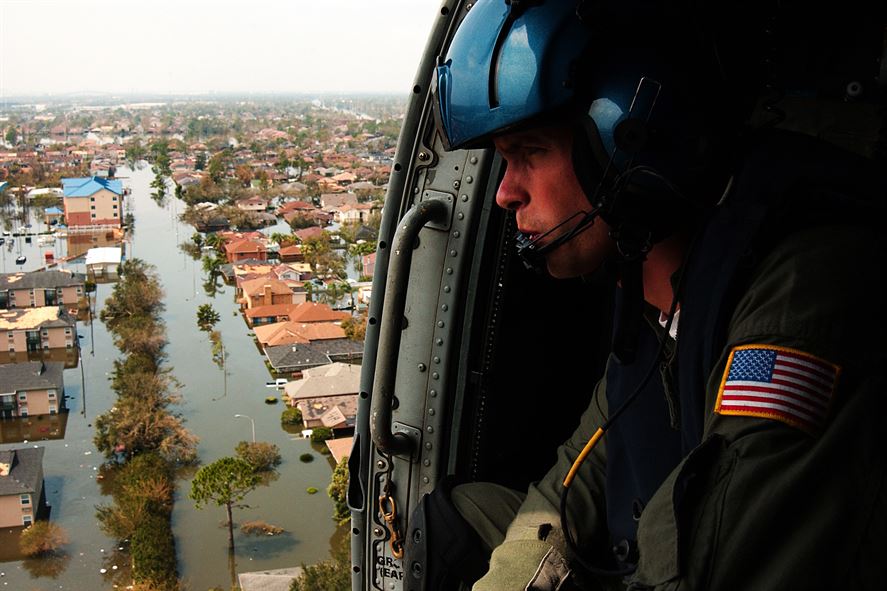
Coast Guard Petty Officer 2nd Class Shawn Beaty looks for survivors in the wake of Hurricane Katrina in New Orleans, Aug. 30, 2005. Beaty is a member of an HH-60 Jayhawk helicopter rescue crew sent from Clearwater, Fla., to assist. U.S. Coast Guard photo by Petty Officer 2nd Class NyxoLyno Cangemi

Navy Lt. Larry Anderson helps Air Force Col. Norma Allgood and her 15-month-old son out of an aircraft on Naval Air Station Jacksonville, Fla., Aug. 31, 2005. Allgood and her family, assigned to Keesler Air Force Base in Biloxi, Miss., were medically evacuated from the area after Hurricane Katrina devastated the Gulf Coast. Anderson, a flight paramedic, is assigned to the Naval Air Station Jacksonville Branch Medical Center. U.S. Navy photo by Miriam S. Gallet

A Navy Seabee uses a chainsaw to remove fallen trees in Gulfport, Miss, Aug. 31, 2005, in the aftermath of Hurricane Katrina. U.S. Navy photo by Petty Officer 3rd Class Ja'lon A. Rhinehart

Air Force medics prepare patients for evacuation at the New Orleans International Airport in New Orleans, Sept. 1, 2005. The airmen are assigned to the 433rd Aeromedical Evacuation Squadron and the 375th Medical Group. U.S. Air Force photo by Master Sgt. Lance Cheung

Crews carry Hurricane Katrina victims who were airlifted into New Orleans International Airport in New Orleans, Sept. 2, 2005, via U.S. military transport. Emergency medical crews were on hand to provide care to those with special needs. U.S. Air Force photo by Staff Sgt. Jacob N. Bailey

A soldier directs Hurricane Katrina victims as they exit the back of an Army CH-47 Chinook helicopter during relief efforts in New Orleans, Sept. 3, 2005. The soldier is an Army National Guard air crewman. Army guardsmen were mobilized to take part in Joint Task Force Katrina, a humanitarian assistance operation led by the Federal Emergency Management Agency in conjunction with the Defense Department. U.S. Navy photo by Petty Officer 1st Class Robert McRill
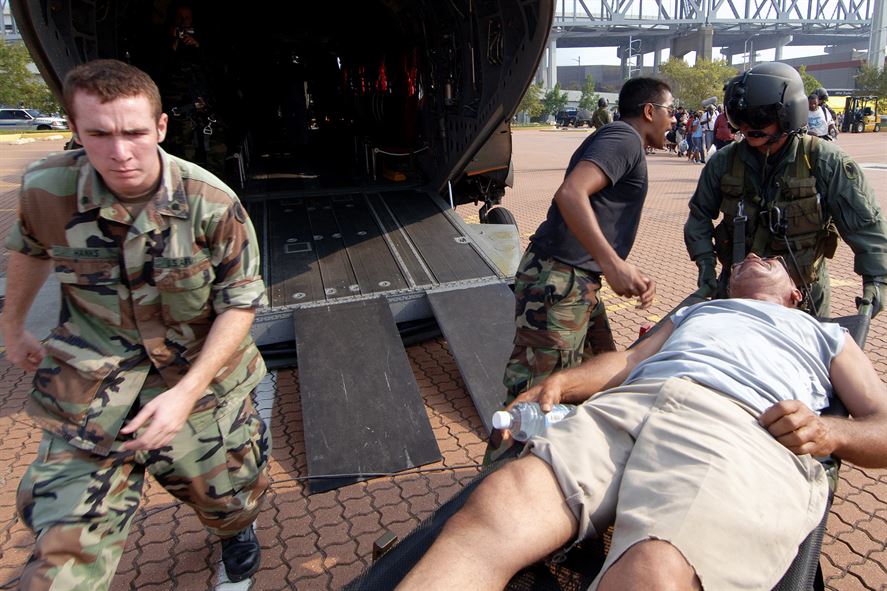
Soldiers and airmen load a Hurricane Katrina victim onto an Army CH-47 Chinook helicopter during relief efforts in New Orleans, Sept. 3, 2005. The soldiers are assigned to the Army National Guard ad the airment are assigned to the Air Force National Guard. U.S. Navy photo by Petty Officer 1st Class Robert McRill
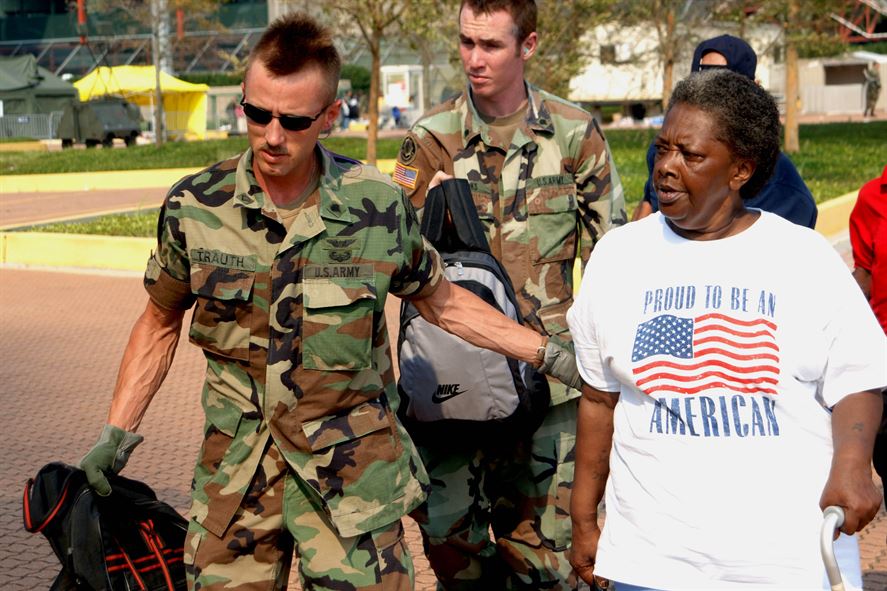
Army Spcs. Trauth and Hanks, members of the Army National Guard, escort hurricane victims to a Army CH-47 Chinook helicopter during Hurricane Katrina relief efforts in New Orleans, La., Sept. 3, 2005. The guardsmen participated in humanitarian assistance operations, a joint effort led by the Defense Department of Defense and the Federal Emergency Management Agency. U.S. Navy photo by Petty Officer 1st Class Robert McRill
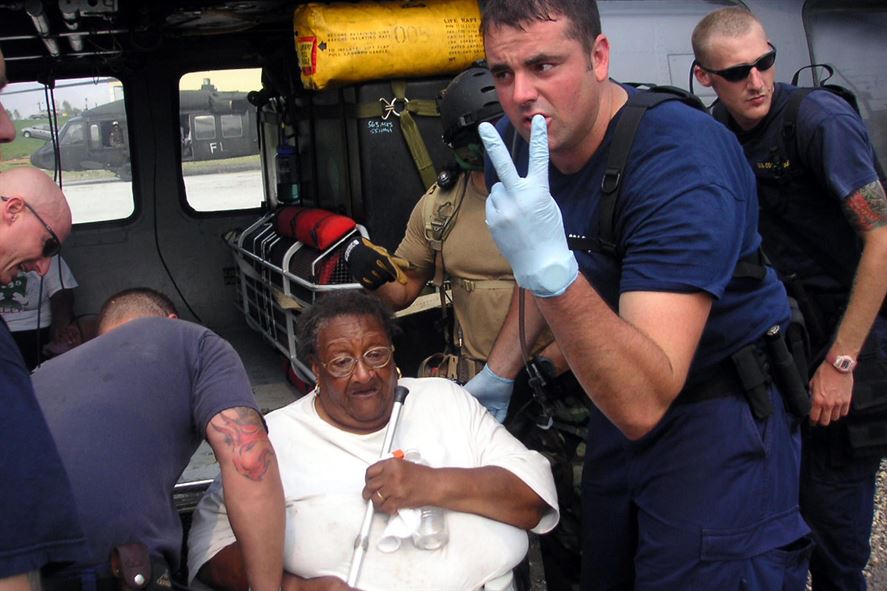
Navy Petty Officer Chuck Hunt signals that his team can load two more Hurricane Katrina victims in addition to the one they are helping into the Army Black Hawk helicopter in New Orleans, Sept. 4, 2005. Hunt is assigned to the Boston-based Coast Guard cutter Spencer. U.S. Coast Guard photo by Petty Officer Sam Towers

Navy search and rescue swimmer Petty Officer 1st Class Scott Chun comforts a victim of Hurricane Katrina pulled from a rooftop as they fly to safety aboard a U.S. Navy SH-60B Seahawk helicopter in New Orleans, Sept. 5, 2005. Chun is a search-and-rescue swimmer. U.S. Navy photo by Petty Officer 3rd Class Jay C. Pugh

A sailor helps a Hurricane Katrina victim fill out paperwork after she was transported to the dock landing ship USS Tortuga in New Orleans, Sept. 5, 2005. Docked in the city, the Tortuga provided hot meals, showers and beds for the victims. U.S. Navy photo by Petty Officer 2nd Class Michael B. Watkins

Airmen and Navy medical personnel lead a Hurricane Katrina victim to a Navy SH-60B Seahawk helicopter for airlift to an evacuation center in New Orleans, La., Sept. 5, 2005. U.S. Navy Petty Officer 3rd Class Jay C. Pugh

U.S. Navy Petty Officer 1st Class Tim Hawkins evacuates a victim of Hurricane Katrina from a rooftop into an SH-60B Seahawk helicopter in New Orleans, Sept. 5, 2005. Hawkins is a search-and-rescue swimmer. U.S. Navy photo by Petty Officer 3rd Class Jay C. Pugh

Army Spc. James Meidl operates a D-7 bulldozer to help clear the roads during humanitarian relief efforts to support Joint Task Force Katrina in Pass Christian, Miss., Sept. 5, 2005. Meidl is a heavy equipment operator assigned to the Army National Guard's 890th Engineering Battalion in Columbia, Miss. DoD photo by Master Sgt James Bowman

Members of the Coast Guard, Sector Ohio Valley Disaster Area Response Team and the Miami-Dade Urban Search and Rescue Team help rescue a Hurricane Katrina victim in New Orleans, Sept. 6, 2005. The Coast Guard is working hand-in-hand with many organizations from around the country to assist the hurricane victims. U.S. Coast Guard photo by Petty Officer Robert Reed

A young Hurricane Katrina survivor hugs her rescuer, Air Force Staff Sgt. Mike Maroney, after she was relocated to the New Orleans International Airport in New Orleans, Sept. 7, 2005. Maroney is a pararescueman assigned to the 58th Rescue Squadron on Nellis Air Force Base. The Air Force Special Operations Command and various Guard rescue squadrons worked together to aid in rescue efforts of Hurricane Katrina victims. U.S. Air Force photo by Airman 1st Class Veronica Pierce
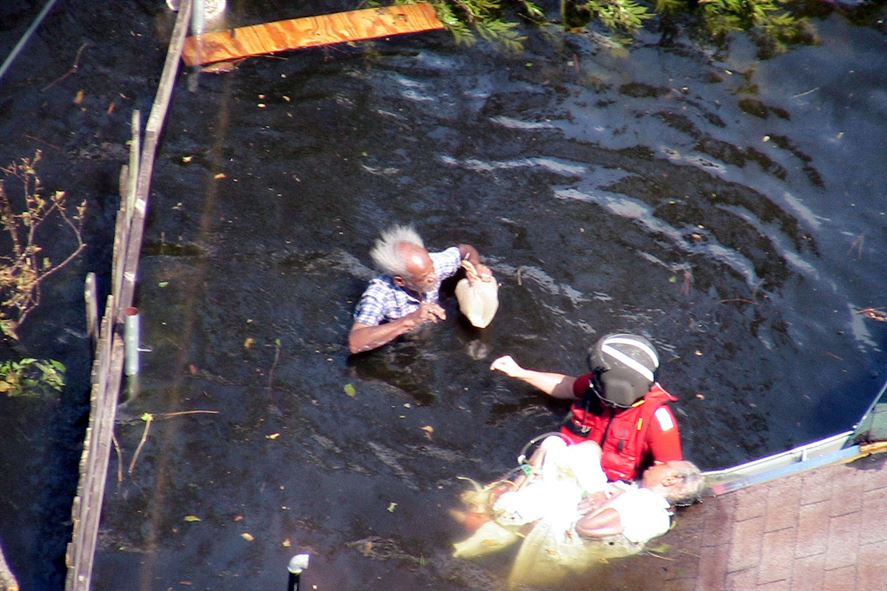
A Coast Guardsman prepares an elderly man and woman for transport to safety in New Orleans, Sept. 7, 2005, following Hurricane Katrina. The Coast Guardsman is a rescue swimmer assigned to USCG Air Station Atlantic City, N.J. U.S. Coast Guard photo

Marines in amphibious vehicles and infantrymen travel down the decimated streets of Orleans Parish conducting search-and-rescue operations in New Orleans, Sept. 8, 2005. Some communities in the parish were under more than 10 feet of water. The Marines are assigned to the Special Purpose Marine Air Ground Task Force Katrina. U.S. Marine Corps photo by Cpl. Rocco DeFilippis

Navy Chaplain Lt. Michael Hendrickson helps clean up the Greek Orthodox Church of New Orleans in New Orleans, Sept. 15, 2005, following Hurricane Katrina. Hendrickson is assigned to the amphibious assault ship USS Iwo Jima, was was pier side on the Mississippi River to assist with Joint Task Force Katrina hurricane relief efforts. U.S. Navy photo by Petty Officer 3rd Class Christian Knoell

Soldiers patrol nearly deserted streets in the French Quarter in New Orleans, Sept. 13, 2005, as part of U.S. military assistance following Hurricane Katrina. The soldiers are paratroopers assigned to the 82nd Airborne Division's Company B, 2nd Battalion, 505th Parachute Infantry Regiment. Photo by Daren Reehl

Marines assist Evelin Jenkins out of their assault amphibian vehicle in New Orleans, Sept. 7, 2005. Jenkins waited 8 days before agreeing to be evacuated from the ruins of Hurricane Katrina. Courtesy photo

Air Force Senior Airman Martin Whalen prepares to cut a sheet of plywood to repair the roof of the Hancock County Historical Society building in Bay St. Louis, Miss., Sept. 20, 2005. Whalen is assigned to the 110th Civil Engineering Squadron. DoD photo by U.S. Air Force Senior Master Sgt. Thomas Meneguin
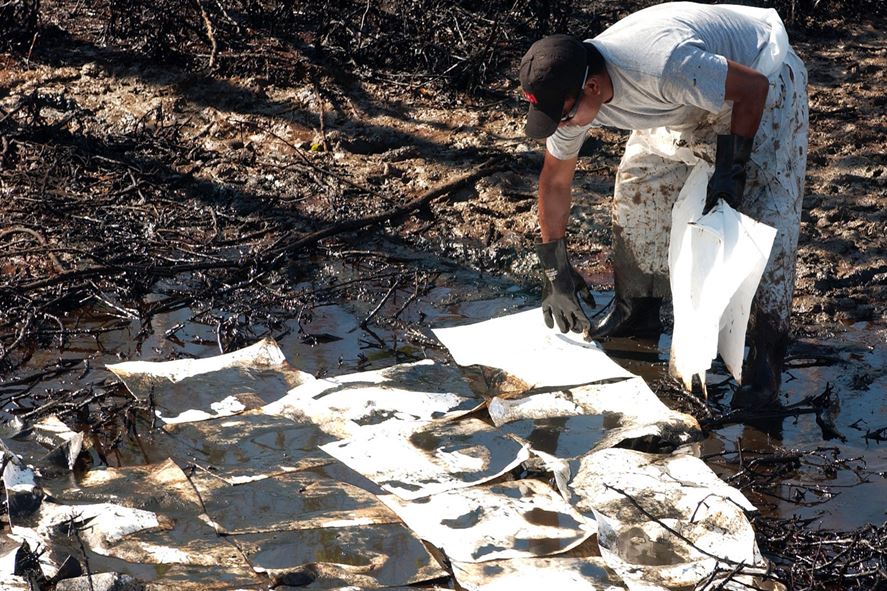
Contractors place absorbent pads on surface oil at the Bass Enterprises South Facility in Cox Bay in Baton Rouge, La., Oct. 6, 2005, following Hurricane Katrina. The hurricane caused an estimated 3.8 million gallons of oil to be released at this facility. A unified command comprised of the Coast Guard and dozens of other organizations focused on cleanup efforts throughout southeast Louisiana. U.S. Coast Guard photo by Petty Officer Mike Lutz

Navy personnel remove debris from ankle-deep water off the coast of Mississippi during the Great American Cleanup event in Biloxi, Miss., March 2, 2006. Naval Mobile Construction Battalion-74 joined volunteers from the surrounding community and across the nation in a continuing effort to clean up and rebuild the Gulf Coast region following Hurricane Katrina in 2005. U.S. Navy photo by Petty Officer 1st Class Rob Wesselman

Navy Petty Officer 3rd Class Paul Johnson uses a front-end loader to move piles of debris from the Gulf of Mexico shoreline in Biloxi, Miss., March 2, 2006, following Hurricane Katrina. Naval Mobile Construction Battalion 74 joined volunteers from the surrounding community and across the nation in a continuing effort to clean up and rebuild the Gulf Coast region following the 2005 hurricane. U.S. Navy photo by Petty Officer 1st Class Rob Wesselman

Navy Seaman Darrel Fincher Jr. carries rolled fencing to a dump truck in Gulfport, Miss., May 1, 2007. Seabees from various battalions from the Naval Construction Battalion Center volunteered to pick up more Hurricane Katrina debris in communities to support the "Keep Gulfport Clean and Green" campaign. Fincher is a Seabee assigned to Naval Mobile Construction Battalion 7. U.S. Navy photo by Petty Officer 2nd Class Demetrius Kennon

Coast Guard Ensign Dan Donovan delivers food to Serenity Dedeaux and her family during Hurricane Katrina recovery efforts in Gulfport, Miss., Sept. 18, 2005. USCG photo by Jeff Hall.